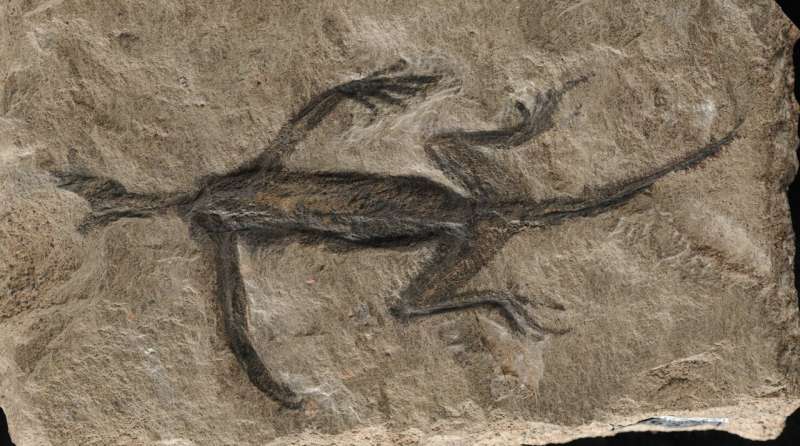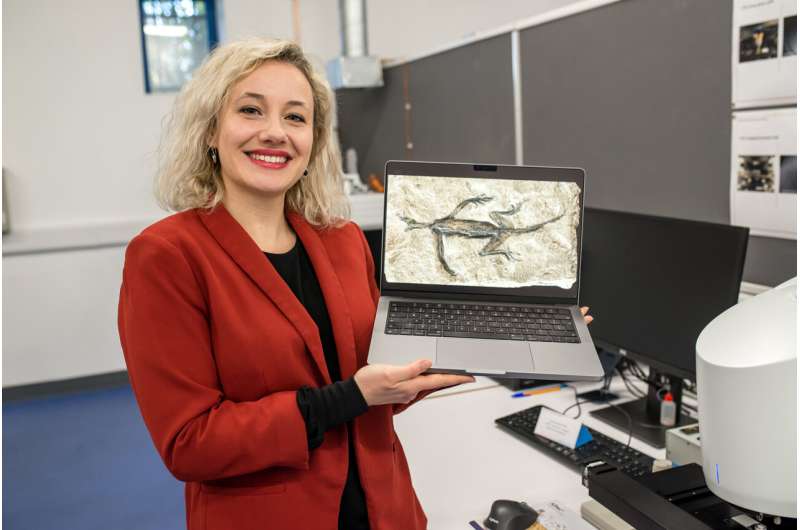This article has been reviewed according to Science X's editorial process and policies. Editors have highlighted the following attributes while ensuring the content's credibility:
fact-checked
peer-reviewed publication
trusted source
proofread
Paleontological analysis shows renowned fossil thought to show soft tissue preservation is in fact just paint

A 280-million-year-old fossil that has baffled researchers for decades has been shown to be—in part—a forgery, following new examination of the remnants.
The discovery has led the team, headed by Dr. Valentina Rossi of University College Cork, Ireland (UCC) to urge caution in how the fossil is used in future research.
Tridentinosaurus antiquus was discovered in the Italian Alps in 1931 and was thought to be an important specimen for understanding early reptile evolution. Its body outline, appearing dark against the surrounding rock, was initially interpreted as preserved soft tissues. This led to its classification as a member of the reptile group Protorosauria.
However, this new research, published in the journal Palaeontology, reveals that the fossil renowned for its remarkable preservation is mostly just black paint on a carved lizard-shaped rock surface.
The purported fossilized skin had been celebrated in articles and books but never studied in detail. The somewhat strange preservation of the fossil had left many experts uncertain about which group of reptiles this strange lizard-like animal belonged to, and more generally its geological history.

Dr. Rossi, of UCC's School of Biological, Earth and Environmental Sciences, said, "Fossil soft tissues are rare, but when found in a fossil they can reveal important biological information, for instance, the external coloration, internal anatomy and physiology. The answer to all our questions was right in front of us; we had to study this fossil specimen in details to reveal its secrets—even those that perhaps we did not want to know."
The microscopic analysis showed that the texture and composition of the material did not match that of genuine fossilized soft tissues.
Preliminary investigation using UV photography revealed that the entirety of the specimen was treated with some sort of coating material. Coating fossils with varnishes and/or lacquers was the norm in the past and sometimes is still necessary to preserve a fossil specimen in museum cabinets and exhibits. The team was hoping that beneath the coating layer, the original soft tissues were still in good condition to extract meaningful paleobiological information.
The findings indicate that the body outline of Tridentinosaurus antiquus was artificially created, likely to enhance the appearance of the fossil. This deception misled previous researchers, and now caution is being urged when using this specimen in future studies.
The team behind this research includes contributors based in Italy at the University of Padua, Museum of Nature South Tyrol, and the Museo delle Scienze in Trento.
Co-author Prof Evelyn Kustatscher, coordinator of the project "Living with the supervolcano," said, "The peculiar preservation of Tridentinosaurus had puzzled experts for decades. Now, it all makes sense. What it was described as carbonized skin is just paint."
However, not all is lost, and the fossil is not a complete fake. The bones of the hindlimbs, in particular, the femurs seem genuine, although poorly preserved. Moreover, the new analyses have shown the presence of tiny bony scales called osteoderms—like the scales of crocodiles—on what perhaps was the back of the animal.
This study is an example of how modern analytical paleontology and rigorous scientific methods can resolve an almost century-old paleontological enigma.
More information: Forged soft tissues revealed in the oldest fossil reptile from the early Permian of the Alps, Palaeontology (2024). DOI: 10.1111/pala.12690
Journal information: Palaeontology
Provided by University College Cork





















